Tuning
The accurate tuning of the bodhrán is just as well as important as a proper playing technique. This does not mean primary to tune the drum to a specific basic tone, it is more important to get an equal tention all over the vibrating surface. If a nice, bassy, earthy tone can be heard on a free vibrating bodhrán (no hand on the skin) the drum is in fine tuning. Furthermore, an equal tone should be heard when hitting the drum skin all around the edge at approximately 1"-2" from the edge. The bass tone should have a warm sound character, an earty sound color and a nice post-pulse oscillation.
My drums are built to provide a huge sound spectrum without any efford. Please just make sure you don't cover too much of the playing surface with your upper part of the body. Same applies for left hand work: Only a lightest tough is necessary to change the tone.
In this case less is more: Less body contact to the drum and less playing effort provides more volume and fuller overall sound. Let the drum do the work ! :-)
Over the years I have developed and refined suitable tuning systems for different drums. 'Tuning system' means to me much more than just a screw pushing against a tuning ring. For me, a tuning system is a complex construction of matching components. Drum skin, bearing edge, frame parts and operating elements have to form a harmonious unit. Not every skin makes sense on every frame/bearing edge. It has specific reasons why I use exclusively 'Standard skin' on the BasicLine, apply a thin leather strip on the bearing edge of the MHTF and work with a textile coating on the tuning ring of the MOF, and so on.
Especially with custom made bodhráns all components will be selected matched and fitted, right from the beginning. Optimal sound results and playing comfort will always be in the focus. Even if the diverse tuning systems are operated slightly differently and also influence the exterior look of the drums in different ways, all of them have many things in common:
-
- All of them are tool-less. No tools are required to keep your instrument in perfect tuning - quick and comfortable, no matter where you are in the world.
- All of them are multipoint tuning systems. This means it is possible to tune differnet parts of the playing surface individually. In my opinion this is strictly necessary for natural drum skins. Sometimes only a single part of the drum skin detunes because of hand perspiration. If you once are used to proper tuned drums you will LOVE my tuning systems !
- All of them are smooth-running. All operating parts are easy to grip and even at very low skin tention the adjusters will not loosen unintentionally.
- All of them are reliable and proven over years. My tuning systems have a large tolerance space in both direction. This means the system works in all climates and conditions. Well, in nearly all ...for sauna use I would like to recommend the Synthetwitschak ;-)
- All of them have a high durability. Only the best quality material is used in all parts. The systems work without maintenance, but of course a drop of oil every now and then can work wonders.
- All of them provide a direct skin tension feedback. This means the amount of rotation resistance on the adjusters provide a straight feedback signal of the skin tension. The higher the skin tention on one specific area, the higher the rotation resistance on the appropriate tuner. Now tuning with intuition is just a question of sensitiveness and routine.
Proper tuning made easy !
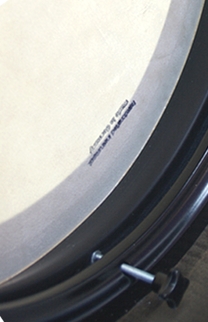
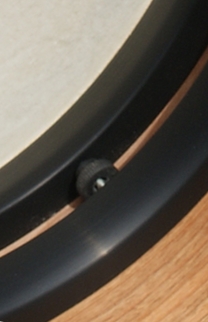
THE COMPRESSOR TUNING SYSTEM
In the years 2010/2011 we developed the so-called compressor tuning system in close cooperation with Rolf Wagels. This is a relatively high, funnel shaped tuning ring which influences the overtones and the overall frequencies of the bodhrán in a positive way.The drums fitted with the compressor rim give a defined and dry sound which on the one hand makes recording and mixing easier and on the other hand allows the drum to cut through very well acoustically without being loud.

More details:
Drums fitted with the compressor rim show a more defined, clear and dry sound compared to a classical tuning system. So these drums can be heard better when mixed with other instruments without being loud or obtrusive. The clear sound makes the compressor tuned drums your best choice for studio work and in an amplified live environment.
If you compare the structure of overtones to a classical bodhrán you will realize that the compressor frame provides a more regulated and a clearer structure. This means that the partial tones have a sharply bounded line and undefined overtone areas are often compressed to one defined overtone.
The two pictures below show a picture of the frequency analysis of a new RWE with a new skin (not played in). The picture on the top shows the results of the classic tuning system, the picture at the bottom is the result of the new compressor tuning system. The curves represent the presence of the frequencies in the full tonal spectrum. The peaks representing the partial tones, means the basic tone and the overtones.
A defined tone has sharp and marked off peaks, whereas a noise has less to no peaks.Please compare the pictures of the drum analysis with the picture of the structure of overtones of a guitar to see how big the influence of the new rim can be. The pictures here show analysis taken from free vibrating drums. More analyze pictures and information regarding other drum models, skins and different left-hand-techniques (free swinging, open, bass, mid, octave, pushed, high plopp) will be available as a pdf document soon.
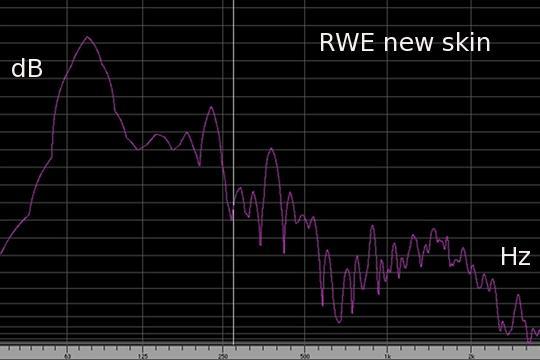
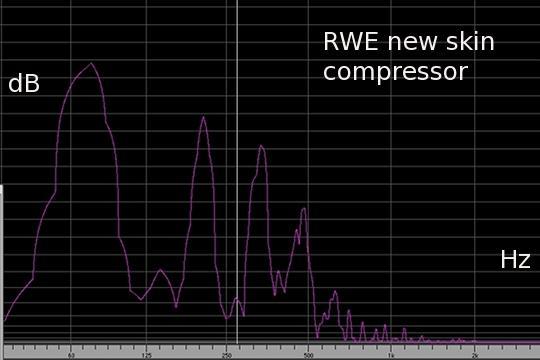
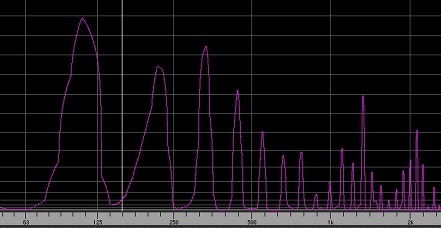
Since all overtones are well structured it is easier to mix the drum either on stage or studio. Also, the bass is less boomy/roaring and better controlable. Another advantage apart from the positive influence of the sound is more playing comfort. The funnel tuning rim gives the skin hand a nice rest, no screws are touched and so you get a comfortable and ergonomic place for your skin hand. Also the way the tuning screws are fixed has changed from single tuning block to a wooden frame going all the way around the drum. This provides a solid fixation and professional look.

All compressor tuning system developments were accompanied and advised by Rolf Wagels. He is so convinced about the new system that it will be standard in his signature line, the RolfWagelsEdition.

In all custom made drums the new compressor rim is optional in two varieties: On the one side we offer the open star tuner knob known from the HighEndLine bodhráns and on the other side the hidden tuning wheels, known from LightLine, BasicLine, MOF and MHTF.
Surcharge is 35€ either way in the HighEndLines 37cm and 40cm. For smaller diameters we can offer the new tuning rim in the closed system only!
The flexibility of the tuning rim will be adjusted individually, according to the skin, diameter and number of tuning screws. To achieve this individual flexibility from super flexible to very stiff the tuning rim is milled on the outside (not visible in the finished drum!).
The new tuning rim can be fitted with or without leather/textile stripe underneath the drum skin.
Since the new compressor frame changes the tone in a significant way all, the classical HighEndLine tuning system is still available. Also the standard models like MOF, MHTF, MOS etc. will still have the classic tuning system as their standard.
Any model can be fitted with the new tuning rim though if the customer wishes to do so.
Please get in touch for individual advice if you are interested in a custom made bodhrán.
And here comes the feedback we got from Martin O`Neill who had the first MOF with compressor tuning system for a test drive:
I've been playing the drum loads and my overall impression is that mic'ed up the bottom end seems more controllable (i.e. Not so boomy),fairly even across the range…
...
One difference not sound related that I do prefer is the funnel shape of the tuning rim makes it more comfortable to play. Small thing, but does make a difference.
Martin O`Neill
The owner of the first compressor MOS 40cm (DRAGONSkin) sent us following lines:
...Due to general chaos I didn't really get a proper soundcheck as I would have liked...so didn't get a chance to let rip with the MOS compressor to see what it sounded like miked up, and the sound that was coming back through the stage monitor was pretty horrible too ! However I have had a lot of positive comments about how well the drum sounded at the concert including an unsolicited " You know, your drum sounded better tonight than it has ever done ", this latter from a friend I have played a lot with over the last few years with my MOS...and like most folk I know, he hasn't realised I was playing a different drum !
So obviously the difference in sound between the two drums is quite noticeable, even to a casual listener... so I am seriously impressed with the compressor design and my new MOScompressor !...
Paul Dorricott, U.K.
Der Besitzer der ersten MOS 40cm (DRAGONSkin) mit Kompressorrahmen hat Folgendes geschrieben:
...Due to general chaos I didn't really get a proper soundcheck as I would have liked...so didn't get a chance to let rip with the MOS compressor to see what it sounded like miked up, and the sound that was coming back through the stage monitor was pretty horrible too ! However I have had a lot of positive comments about how well the drum sounded at the concert including an unsolicited " You know, your drum sounded better tonight than it has ever done ", this latter from a friend I have played a lot with over the last few years with my MOS...and like most folk I know, he hasn't realised I was playing a different drum !
So obviously the difference in sound between the two drums is quite noticeable, even to a casual listener... so I am seriously impressed with the compressor design and my new MOScompressor !...
Paul Dorricott, U.K.
LEATHER STRIP ON BEARING EDGE
What´s the story about the soft leather strip underneath the drumskin ??? This leather strip works like a buffer zone. I makes the whole drum a bit less frail for de-tuning and allows the drum skin to swing out better in the edge area. It also softens a bit the rim shot sound, takes away some ringing overtones and avoids a possibly squeaking of the skin.
Depending on drum model, skin and the desired sound, this leather strip is used in various thicknesses/qualities. Some drum models are not equipped with this leather strip. A special coating or textile layer is then applied.
TAPING
The tape helps to harmonize the overtone behavior, and thus the drum sound, and simply makes the overall sound more defined and "rounded".
Physically, it dampens the radial lines of vibration of the drumhead, while the circular lines are not affected.
The tape I use is regular electrical tape. But the differences between the various types/brands are considerable. Some tapes just lay down on the skin, others have an internal tension that pulls the skin inward a bit.
I've tried pretty much all the different types, and also what effect it has on how deep you tape into the playing surface. We even did sound analysis with it at the acoustics department at the University of Munich.
It also makes a difference how many layers you put and how much you pull the tape when you apply it. So it's not only a visual difference, but also a sonic difference if you use the same tape, but 12, 19 or 35mm wide.


